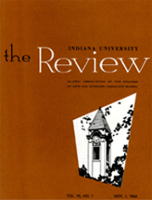The Review
Indiana University
Alumni Association of the College of Arts and Sciences—Graduate School
November 1, 1964
Vol. VII, No 1
A Half Century Of Political Science
By Charle S. Hyneman
The first graduate assistant in political science at Indiana University returned to the campus in 1956 and five years later became Distinguished Service Professor of Government

 The College of Arts
The College of Arts